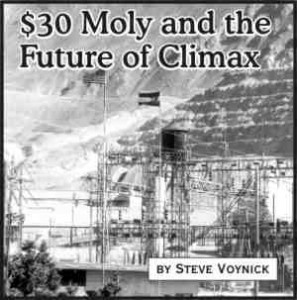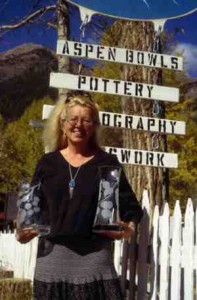Review by Ed Quillen
Local History – July 2005 – Colorado Central Magazine
Currents of Change – A new era for the Upper Arkansas,. Salida, Buena Vista, Poncha Springs
edited by Pat Windolph
Published in 2005 by Arkansas Valley Publishing
No ISBN
IN BRIEF, this book might be summarized as “How a mountain valley went from Rust Belt to Banana Belt in 25 years.” A handsome 192-page production, it celebrates the querquicentennials of Salida and Poncha Springs, as well as the 125th birthdays of two newspapers, the Chaffee County Times in Buena Vista and The Mounain Mail in Salida.
Instead of going all the way back to 1880, though, Currents focuses on the past 25 years, when the upper Arkansas River valley from Salida through Buena Vista to Leadville underwent a gut-wrenching transformation.
It is hard to explain to later arrivals just how much this area relied on Climax Molybdenum and the immense payroll that was spent by its 3,000 employees in 1980, and how much of a shock it was when lay-offs were announced in late 1981, followed by a complete shut-down.
Also, Climax’s traffic helped keep the trains running, and it wasn’t the only mine around here with a payroll – and those other mines also closed in the early 1980s. Dozens of little locally owned stores closed, too, and empty storefronts abounded. You could buy a small house for less than $30,000 then, but few people were buying.
NOT THAT THINGS are perfect now, but with art, tourism, and recreation, Salida and Buena Vista haven’t turned into ghost towns. They’re thriving, more or less, even after the shocks of 2001 and 2002; including the terrorist attacks which stifled tourism for a time, and perhaps the worst drought in 300 years, which was accompanied by major forest fires in neighboring counties that blackened local skies for days.
So the last 25 years are a tale of perseverence and creativity, people trying to find a way to keep living in a valley they cherish. It is those stories that Currents sets out to tell, and by and large, it does a good job.
It’s not exactly an anthology, but it does draw from 25 local writers (Martha and I among them) to cover various facets of the past quarter-century, ranging from the decline of heavy industry to the rise of recreation: retail changes, educational adjustments, an astonishing growth in the performance arts, medical care – indeed, just about every facet of civic life.
With so many different writers and viewpoints, the quality does vary. Every piece was decent, though.
But some really shined. To put it another way, there are pieces in Currents that I wish we’d run here, like Alan Robertson’s account of the Brown’s Canyon wilderness controversy and the contention and compromise that produce the travel management at the nearby Fourmile area northeast of Buena Vista.
Denise Ronald does a fine job of explaining how the Salida schools fell into a fiscal crisis, a story that dribbled out over the years, and how they recovered, gaining enough public confidence to pass a bond issue for a new middle school.
Another stellar piece, which took a long and complex story and put it into a coherent and engaging narrative, was Mail publisher Merle Baranczyk’s account of the Salida Hot Springs Aquatic Center and its new pipeline, a tale of engineering mishaps, convoluted finance, municipal mismanagement, emblezzlement, and insurance litigation, just for starters.
ABOUT THE ONLY THING that’s missing is a phone call I got back when I worked at the Mail (1978-83). One morning, after a city council meeting, which was mostly devoted to what could the city do about its cash-draining pool, a woman called to explain why the city had so much trouble: If God had wanted a hot-springs pool in Salida, He’d have put the hot springs in Salida, rather than at Poncha.
Beyond its 50-plus chapters, Currents has four appendices, providing a handy source for some compiled statistics, like sales taxes and recreational visits, that can be hard to come by elsewhere, even on the Internet.
The only glaring flaw I found was the index – it’s adequate, but not as complete as it should be.
By and large, though, Currents does what it set out to do; it chronicles and explains what happened in the past 25 years, when a century’s worth of industrial work collapsed almost overnight, and our valley had to find a new course.


